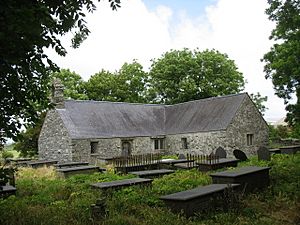Old Church of St Afran, St Ieuan and St Sannan, Llantrisant facts for kids
Quick facts for kids Old Church of St Afran, St Ieuanand St Sannan, Llantrisant |
|
|---|---|

The church from the southwest
|
|
| Lua error in Module:Location_map at line 420: attempt to index field 'wikibase' (a nil value). | |
| OS grid reference | SH 350 840 |
| Location | Llantrisant, Anglesey |
| Country | Wales |
| Denomination | Church in Wales |
| Website | Friends of Friendless Churches |
| History | |
| Dedication | Saint Afran, Saint Ieuan and Saint Sannan |
| Architecture | |
| Functional status | Redundant |
| Heritage designation | Grade II* |
| Designated | 5 April 1971 |
| Architectural type | Church |
| Closed | 1899 |
| Specifications | |
| Materials | Stone, modern slate roof |
The Old Church of St Afran, St Ieuan and St Sannan, Llantrisant is a very old church in a place called Llantrisant, Anglesey, Wales. It's not used for regular church services anymore, so it's called a "redundant church." This special building is protected as a Grade II* listed building by an organization called Cadw. It is now looked after by a group called the Friends of Friendless Churches. The church is in a quiet, isolated spot next to a farm.
Contents
History of the Old Church
The church is named after three saints: Afran, Ieuan, and Sannan. The name "Saint Afran" might actually come from "Saint Afan." Saint Afan was a bishop and a holy person in Wales during the 500s. He was connected to a royal family in Gwynedd.
This church was likely built a very long time ago, in the late 1300s. A small chapel was added to the south side in the 1600s. In 1899, a new church was built closer to the center of Llantrisant, about 1.5 kilometers (1 mile) to the east. Because of this, the old church was no longer needed for services.
Over time, the old church started to fall apart. By 1937, it was in bad shape, and by 1970, it was mostly ruins with no roof. Luckily, it was repaired and restored between 1976 and 1977. In 1978, the church was officially given to the Friends of Friendless Churches. This charity now has a very long lease, for 999 years, to care for the building. It was one of the first churches in Wales that this charity took care of.
Church Architecture and Design
The Old Church of St Afran, St Ieuan and St Sannan is built from stone and has a new roof made of slate. Its design is quite simple. It has a main hall, called the nave, which leads directly into the chancel, the area near the altar. There is also a chapel that extends out to the south.
Exterior Features
At the west end of the church, there is a stone gabled bellcote. This is a small structure that holds a bell. On the south wall of the nave, you can see a round-headed doorway. To the left of this door is a single rectangular window. To the right, there is a double window with a large, rough stone above it.
On the north wall, there is another rectangular doorway. To its left, there is a single square window. The east window, at the very end of the church, has two lights (openings) shaped like trefoils (a three-leaf clover design). Between these two lights, there is a small shield-shaped window. The south chapel has double square-headed windows on its east and south walls, and a single rectangular window on its west wall.
Inside the Church
Inside, the church floor is covered with stone slabs. Most of the furniture and fittings inside the church are very old, probably from the 1700s. This includes the box pews, which are like enclosed seating areas, and the benches.
The altar is simple. It's a slate slab supported by stone piers. A simple cross is set into the wall behind it. One of the most interesting items is the font, which is used for baptisms. This font is even older, dating back to the 1100s! It has a deep, round bowl on a cylindrical column, standing on a stepped base. This font wasn't originally from this church. It was moved here from a church in Grove, Buckinghamshire, when that church was turned into a house in the 1970s. You can also see memorials on the walls and a gravestone set on a chest on the floor of the nave.

